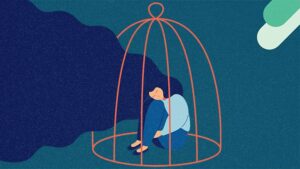Addiction is a harrowing experience that can take hold of anyone, regardless of their background or circumstances. It’s a vicious cycle of compulsive behavior that can be difficult to break without expert help. One approach gaining popularity in the field of addiction treatment is Applied Behavior Analysis (ABA) Therapy. In this post, we’ll explore what ABA therapy entails and how it may offer hope for those struggling with addiction. Join us as we dive into an innovative treatment method that’s changing lives one step at a time.
Contents
What Is ABA Therapy For Addiction?

Applied Behavior Analysis (ABA) therapy is a type of therapy that has been used to treat various behavioral disorders, including addiction. ABA therapy involves the application of behavioral principles to change maladaptive behaviors and promote positive behaviors.
In addiction treatment, ABA therapy is often used in combination with other treatments, such as medication-assisted therapy and counseling. ABA therapy can help individuals with addiction learn new skills and behaviors to replace their maladaptive behaviors, such as drug or alcohol use.
ABA therapy may involve several components, including functional assessments, behavior interventions, and ongoing monitoring and feedback. The therapist may work with the individual to identify triggers for their addictive behaviors and develop strategies to manage those triggers. The therapist may also work with the individual to develop coping skills and promote positive behaviors, such as exercise or socializing with sober friends.
Overall, ABA therapy can be an effective treatment option for addiction when used in combination with other treatments. However, it is important to note that each individual’s treatment plan should be tailored to their specific needs and may involve different types of therapies and interventions.
Elements of ABA Therapy For Addiction

The elements of ABA therapy for addiction include the following:
- Functional Assessment: The first step in ABA therapy for addiction is conducting a functional assessment. This involves identifying the factors that contribute to the individual’s addictive behaviors. These factors may include environmental triggers, social cues, emotional stressors, or other factors that reinforce drug use.
- Behavior Intervention: Based on the functional assessment, the therapist will develop a treatment plan that includes behavior interventions. The interventions may include skills training, positive reinforcement, and behavioral modification techniques. The goal of these interventions is to teach the individual new behaviors that are incompatible with their addictive behaviors.
- Monitoring and Feedback: The therapist will monitor the individual’s progress throughout the treatment process and provide ongoing feedback. This helps to ensure that the individual is making progress and that the treatment plan is effective. The therapist may also make adjustments to the treatment plan as needed to address any challenges or obstacles that arise.
- Skills Training: ABA therapy for addiction typically includes skills training to help individuals develop new coping strategies and problem-solving skills. This may involve teaching individuals how to manage cravings, develop healthy habits, and cultivate a support system of sober friends and family.
- Positive Reinforcement: Positive reinforcement is a key element of ABA therapy for addiction. The therapist may use rewards or incentives to reinforce positive behaviors, such as staying sober or attending support group meetings. This helps to promote motivation and encourages the individual to continue making progress.
Overall, ABA therapy for addiction is a comprehensive treatment approach that focuses on changing maladaptive behaviors and promoting positive behaviors. The therapy involves a structured and individualized approach that is tailored to the specific needs of the individual.
Working on ABA Therapy For Addiction

The working of ABA therapy for addiction involves several key principles and techniques. These include:
- Reinforcement: ABA therapy uses positive reinforcement to encourage and reward positive behaviors. This may include providing rewards or incentives for staying sober, attending support group meetings, or practicing healthy coping skills.
- Behavioral Modification: ABA therapy aims to modify maladaptive behaviors by teaching new skills and behaviors. This may involve skills training, problem-solving techniques, and other behavioral modification techniques to promote positive change.
- Functional Analysis: ABA therapy uses functional analysis to identify the underlying causes of addiction. By understanding the factors that contribute to addictive behaviors, the therapist can develop a more effective treatment plan.
- Individualized Treatment: ABA therapy is tailored to the specific needs of each individual. The therapist works closely with the individual to develop a treatment plan that addresses their unique challenges and goals.
- Ongoing Monitoring: ABA therapy involves ongoing monitoring to track progress and identify areas for improvement. The therapist may make adjustments to the treatment plan as needed to ensure that the individual is making progress.
Overall, the goal of ABA therapy for addiction is to promote positive change and help individuals overcome their addictive behaviors. The therapy involves a structured and individualized approach that focuses on reinforcing positive behaviors, teaching new skills and behaviors, and addressing the underlying causes of addiction.
Pros and Cons of ABA Therapy For Addiction
Like any treatment approach, ABA therapy for addiction has its own set of pros and cons. Some potential pros and cons of ABA therapy for addiction are:
Pros
- Evidence-Based: ABA therapy is an evidence-based treatment approach that is effective in treating addiction, particularly when used in combination with other treatments.
- Individualized Treatment: ABA therapy is tailored to the specific needs of each individual. This allows for a more personalized treatment approach that can address the unique challenges and goals of each person.
- Positive Reinforcement: ABA therapy uses positive reinforcement to encourage and reward positive behaviors. This can be a powerful motivator for individuals to continue making progress in their recovery.
- Skills Training: ABA therapy includes skills training to help individuals develop new coping strategies and problem-solving skills. This can be particularly beneficial in preventing relapse and promoting long-term recovery.
Cons
- Time-Intensive: ABA therapy can be a time-intensive treatment approach, requiring frequent sessions with a therapist. This may be challenging for individuals with busy schedules or limited resources.
- Requires Commitment: ABA therapy requires a commitment to making behavioral changes and following through with the treatment plan. This can be challenging for individuals who are not fully committed to the recovery process.
- Limited Availability: ABA therapy may not be widely available in all areas or may be cost-prohibitive for some individuals.
- Lack of Diversity: ABA therapy may not be culturally sensitive or inclusive of diverse backgrounds and experiences.
It is important to note that the effectiveness of ABA therapy for addiction can vary depending on the individual and their specific needs. It is recommended that individuals work closely with a healthcare professional to determine if ABA therapy is an appropriate treatment approach for them.
Alternatives to ABA Therapy

There are several alternative therapies to ABA therapy for addiction. Some of these include:
- Cognitive Behavioral Therapy (CBT): CBT is a type of therapy that helps people to understand and change the thoughts and behaviors that contribute to their addiction.
- Dialectical Behavior Therapy (DBT): DBT is a type of therapy that focuses on helping people to cope with the stress and emotions that can trigger addictive behaviors.
- Eye Movement Desensitization and Reprocessing Therapy (EMDR): EMDR is a type of therapy that uses eye movements to help people process and heal from trauma, which can be a trigger for addiction.
- Hypnotherapy: Hypnotherapy is a type of therapy that uses hypnosis to help people make changes in their thoughts, feelings, and behaviors.
- Neurolinguistic Programming (NLP): NLP is a type of therapy that uses language and communication techniques to help people change their thoughts and behavior.
- Motivational Interviewing (MI): MI is a type of therapy that helps people to become more motivated to make changes in their lives and behaviors.
Conclusion
ABA therapy has proven to be an effective treatment for individuals struggling with addiction. It can provide clients with the tools they need to manage their cravings and behaviors, while also providing them with a safe environment in which to work through any underlying issues that may be contributing to the addiction. Overall, ABA therapy is a powerful tool for addressing addictive behavior and gives people the chance to reclaim their lives.
For more information, please contact MantraCare. Addiction is a chronic and often relapsing disorder characterized by compulsive drug-seeking and use despite harmful consequences. If you have any queries regarding Online Addiction Counseling experienced therapists at MantraCare can help: Book a trial Online therapy session


